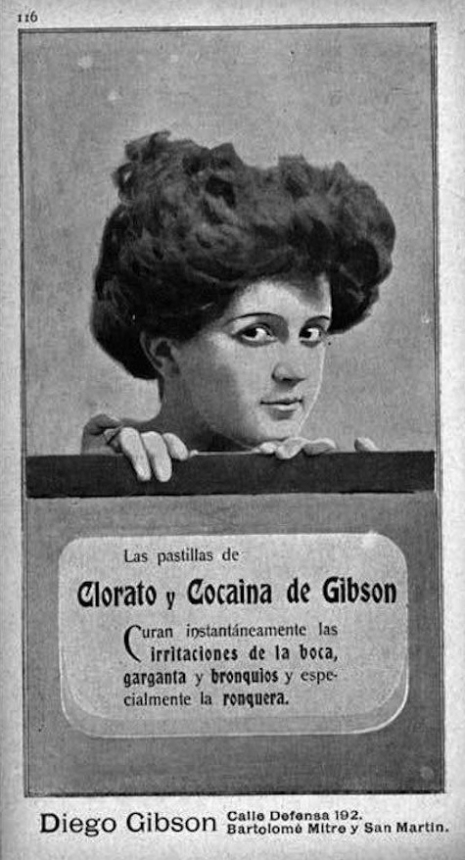Antique Ads from the Days of Legal Heroine and Cocaine
Pope Leo XIII’s longevity as Pontiff of the Catholic Church (the third longest in church history) may have been down to his favourite tipple Vin Mariani. Pope Leo was so enamoured by this French tonic wine it is claimed he kept a hip flask hidden under his cassock, so he could enjoy the occasional snifter to perk up his spirits—which it undoubtedly did, as Vin Mariani was a heady mix of Bordeaux wine and coca leaves. The original drink had 6mg of cocaine per fluid ounce, which went up to 7.2mg per fluid ounce for the export market—mainly to compete with similar coke-filled tonics—such as Coca-Cola—sold in the USA.
It was claimed that Mariani wine could quickly restore “health, strength, energy and vitality,” and hastened convalescence (“especially after influenza”). In one of their ads, His Holiness the Spokesmodel decreed.
Talk about a celebrity endorsement, eh? If God’s representative on Earth approved of the coca-infused tipple, that would have been quite a boon in marketing terms.
Cocaine enhanced drinks were common in the late 1800s, and there is an academic paper to be written on the influence of cocaine and the rise of the British Empire—how else to explain the sound of grinding teeth among all those overworked lower classes whose labor put the Great into Britain?
But it wasn’t just adults who benefited from the restorative powers of cocaine, it was added to pastilles for teething children, throat lozenges for flu and colds, and as a cure for hay fever.
One family favorite was Mrs. Winslow’s Soothing Syrup, first sold in 1849, which contained 65 grams of morphine sulphate per fluid ounce. This little medicine was also a cause of infant mortality, as one doctor noted at the time:
“Opium killed far more infants through starvation than directly through overdose. [Infants] kept in a state of continued narcotism will be thereby disinclined for food, and be but imperfectly nourished.”
The British Prime Minister William Gladstone called opium his little “pick-me-up” and regularly added it to his coffee. The list of eminent Victorians who used the drug included:
Elizabeth Barrett Browning, Wilkie Collins (who persuaded Dickens to become an opium user), John Keats, William Wilberforce and Florence Nightingale, who was one of the first patients to be given opium by her doctor in the form of hypodermic morphine.
But opium addiction was not just for the rich or “those seeking oblivion in the slums.”
Paradoxically the highest consumption of opium was by agricultural workers in the Fens, where opium taking had long been common and excessive.
For most of the 19th century, the opium users in the Fens, as elsewhere, could buy the drug from any corner shop that liked to stock it, but during that century there was increasing pressure from the medical and pharmaceutical professions for the supply of opium to be limited to chemists or on prescription from doctors (many doctors, then as now, supplied prescription drugs). The doctors would have liked to go further and to restrict supply to prescriptions only, and proposed this move in the 1868 Pharmacy Act, but pharmacists in the Fenland areas panicked and persuaded the Pharmaceutical Society that opium sales accounted for such a high proportion of their incomes that curtailment would put them out of business. “So what!” was understandably the doctors’ response, but the Pharmaceutical Society carried the day and chemists were able to go on obliging their opium customers well into the 20th century.
The London Society of Arts “instituted awards of 50 guineas or a gold medal to encourage the production” of opium in England and Scotland:
The Society met with some success, for over a hundred years the plant was grown in Somerset, Buckinghamshire, Middlesex, Surrey, around Edinburgh and, where it flourished best, in Norfolk. The crop was harvested by cheap labour, children aged eight to 12, casual women labourers, and by Irish immigrants. The youngest children were paid three pence for an 11-hour day, the women and the Irish a shilling.
The reasons for growing the white poppy, Papaver somniferum, as it was less expensive than the raw opium being imported from Turkey. It is thought that the plant had been brought to England by the Romans (along with garlic, olives and grapes) where it was successfully grown in Norfolk Fens. Here it became indigenous to the area, where it was to have “a longstanding tradition of reserving a patch of the garden for the plant, for making poppy head tea as a medicine.”
Opium use for both personal and medicinal reasons became prevalent throughout the United Kingdom during the 19th century, this at a time when the country was involved in two “Opium Wars” (1839–1842 and 1856–1860) with China over opening trade routes and administrative bases, and supplying opium.
(View original article with all the photos here)



